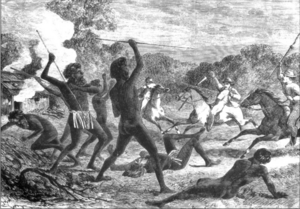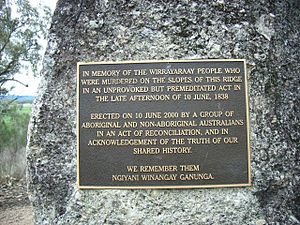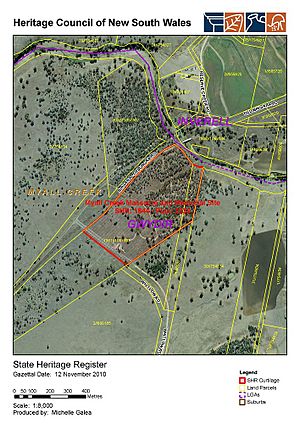Myall Creek Massacre and Memorial Site facts for kids
Quick facts for kids Myall Creek Massacre and Memorial Site |
|
|---|---|

Sketch of "Aboriginals fighting against the Europeans invading their natural homes", by Samuel Calvert
|
|
| Location | Bingara Delungra Road, Myall Creek via Bingara, Gwydir Shire, New South Wales, Australia |
| Built | 1838– |
| Owner | Gwydir Shire Council; Land and Property Management Authority (LPMA) |
| Official name: Myall Creek Massacre and Memorial Site; Myall Creek Massacre Area | |
| Type | state heritage (landscape) |
| Designated | 12 November 2010 |
| Reference no. | 1844 |
| Type | Historic site |
| Category | Aboriginal |
| Lua error in Module:Location_map at line 420: attempt to index field 'wikibase' (a nil value). | |
The Myall Creek Massacre and Memorial Site is a special place in New South Wales, Australia. It remembers a sad event called the Myall Creek massacre. This site is located near Myall Creek via Bingara.
A memorial was built here in 2000 to honor the victims. This important site is now listed on the Australian National Heritage List and the New South Wales State Heritage Register.
Contents
What Happened at Myall Creek?
After the First Fleet arrived in Australia in 1788, European settlers began to spread out. The first Governor, Arthur Phillip, was told to treat Aboriginal people kindly. However, as more settlers arrived, they needed more land and resources. This often led to fighting between Aboriginal people and settlers.
Both Aboriginal people and settlers were legally considered British subjects. This meant they should have had the same rights and protection under the law. But it was hard for the government to make sure these laws were followed, especially in faraway areas.
The Myall Creek massacre happened in 1838. It was a very important event because of what happened next. Seven settlers were found guilty and punished for killing Aboriginal people. This was the first and last time that settlers were punished in this way for such a crime on the frontier.
This event showed that the government tried to apply the law equally. However, instead of stopping the violence, it made some settlers even more determined to take land. They didn't want the law to get in the way of their plans.
Exploring the Memorial Site
The Myall Creek memorial site is on gentle hills. Most of the land is now used for grazing sheep and cattle. You can still see native trees like White Box and Red Gum here. This area is also part of a route used for moving cattle.
The memorial starts with two large basalt rocks. From there, a 600-meter path made of red gravel winds through trees and grass. Along this path, there are seven oval-shaped granite boulders. These boulders have plaques with words in English and Gamilaroi, telling the story of the massacre.
At the end of the path, the main memorial stands on a small hill. It overlooks the place where the massacre happened. The memorial is a large 14-tonne granite boulder. It has a simple plaque and is surrounded by a circle of white crushed granite. Stones from all over New South Wales form the edge of this circle.
The bronze plaque on the memorial says:
- In memory of the Wirrayaraay people who were murdered on the slopes of this ridge in an unprovoked but premeditated act in the late afternoon of 10 June 1838. Erected on 10 June 2000 by a group of Aboriginal and non-Aboriginal Australians in an act of reconciliation, and in acknowledgment of the truth of our shared history. We Remember them (Ngiyani winangay ganunga).
The memorial is mostly made of strong, fire-resistant materials like granite and metal. The Myall Creek Memorial opened in 2000. It is looked after by the Gwydir Shire Council and the Myall Creek Memorial Committee.
Why This Site Is Important
The Myall Creek massacre was a very brutal event where about 30 Wirrayaraay and Gamilaroi people were killed in June 1838. The court cases and the punishment of the seven settlers were a turning point in the relationship between settlers and Aboriginal people in New South Wales. It was the last time the government tried to use the law to control violence on the frontier.
Instead of making things better, it made some settlers even more determined to remove Aboriginal people from the land. The Myall Creek massacre is one of the few well-documented massacres in New South Wales. It helps us understand the violent conflicts that happened when settlers moved into new areas.
The story of Myall Creek has been told for many years. It continues to remind Australians about the unfair treatment of Aboriginal people during this time.
Importance to Aboriginal People
The Myall Creek Massacre and Memorial Site is very important to the Wirrayaraay and Gamilaroi people. They helped create the memorial and continue to be involved in managing the site. Descendants of Aboriginal people who survived the massacre are part of the Myall Creek Memorial Committee.
A Place of Reconciliation
The Myall Creek Massacre and Memorial Site is also important to the local community. It is a symbol of reconciliation, which means bringing people together after conflict. It is also a place for education. Schools and local councils from the area take part in an annual service held at the site.
The memorial helps descendants of both Aboriginal and non-Aboriginal people involved in the massacre come together. In 2003, the Myall Creek Memorial won the Judith Wright Reconciliation Prize. This award recognized its role in bringing people together.
See also
- List of massacres in Australia
- List of massacres of Indigenous Australians




